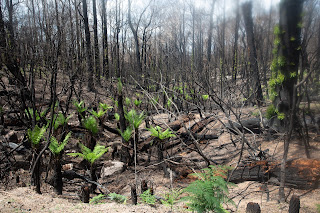Tallaganda Dreaming II:Creek zones - ferns, mosses, worts and lichens
The fire has exposed large areas of creek terrain, previously unseen because of extensive blackberry or bracken growth.
Accessible creek zones in the forest tend to be highly disturbed, partly as a result of past mining or eucalyptus oil extraction or more recent illegal dope plantations, but also as a result of a dramatic increase in erosion caused by the lack of ground cover or tree collapse.
On one unnamed creek, old metal eucalyptus distilleries and pipe work still litter the area together with discarded metal and wooden items. The creek shows signs of modification to suit the extraction operation. Perhaps this facility could be preserved as an example of extraction activities.
Downstream, ferns have been displaced by a small dope plantation (perhaps originally hidden in a now destroyed bracken patch, protected by wire netting). Some creeks show orange discoloration - perhaps the result of leaching of human mining and domestic waste.
Here the creek has eroded into and undercut soft banks, which have recently collapsed in places after heavy rain. While some ferns show signs of regrowth, other remain inactive.
Fire has undercut some trees along the creeks, leaving the creeks in danger of additional erosion after collapse.
Larger east and south facing valleys show most initial regrowth - both of desirable tree ferns and small ferns (fishbone or shield),
In some areas there is extensive growth of less desirable bracken (which, like blackberry) can colonize broad areas excluding other riverine species.
Other posts in the Tallaganda Wilderness Firestorm and Recovery series
I: Index of recovering species, Asura cervicalis in Exocarpos cupressiformis
II: Creek Zones: Ferns, Mosses, Lichens, Worts
III: Southern Boobook Owl Ninox novaeseelandiae
IV: First Wildflowers
V. Fire sculptures
VI. Funnel Web Spider Atrax Sutherlandi
VII. Trees of the Forest - in preparation
VIII. Heaths and shrubs of the Forest - in preparation
IX. Highland Bog Zones - in preparation
X. Mountains Zones - in preparation
Background Chronologies
i. Tallaganda Wilderness Fire 2019-20: Chronology Part 1 24-29 November
ii Tallaganda Wilderness Fire 2019-20: Chronology Part 1 29 November +, in preparation
iii. Tallaganda Wilderness immediately before the fire October 2019 in preparation
2. Cyathea Australis and Blechnum Nudum creek communities
In the initial regrowth period, creek communities are dominated by fast recovering Rough tree fern (Cyathea australis) and the much smaller Fishbone water fern (Blechnum nudum)
Fishbone water fern (Blechnum nudum)
Rough tree fern (Cyathea australis)
Accessible creek zones in the forest tend to be highly disturbed, partly as a result of past mining or eucalyptus oil extraction or more recent illegal dope plantations, but also as a result of a dramatic increase in erosion caused by the lack of ground cover or tree collapse.
First survey image - note full creek but limited growth
Second survey image a week later - note water has dropped, but rapid bracken growth
On one unnamed creek, old metal eucalyptus distilleries and pipe work still litter the area together with discarded metal and wooden items. The creek shows signs of modification to suit the extraction operation. Perhaps this facility could be preserved as an example of extraction activities.
Downstream, ferns have been displaced by a small dope plantation (perhaps originally hidden in a now destroyed bracken patch, protected by wire netting). Some creeks show orange discoloration - perhaps the result of leaching of human mining and domestic waste.
Here the creek has eroded into and undercut soft banks, which have recently collapsed in places after heavy rain. While some ferns show signs of regrowth, other remain inactive.
Fire has undercut some trees along the creeks, leaving the creeks in danger of additional erosion after collapse.
Larger east and south facing valleys show most initial regrowth - both of desirable tree ferns and small ferns (fishbone or shield),
2a. Soft tree fern, Man fern (Dicksonia antarctica)
2b. Maiden hair fern ( Adiantum hispidulum)
Not evident on first survey, a week later this was growing in numerous locations along waterways.
3. Bracken (Pteridium Escalentum)
In some areas there is extensive growth of less desirable bracken (which, like blackberry) can colonize broad areas excluding other riverine species.
4. Fungi
Creeks that are flowing host trees displaying strong trunk regrowth and, during the first survey, diverse fungi species (these had largely disappeared by the time of the second survey). Creek rocks show some moss and lichen re-establishment.
A large fungal mass was also found (possible having fallen from a nearby gum?)
Other posts in the Tallaganda Wilderness Firestorm and Recovery series
I: Index of recovering species, Asura cervicalis in Exocarpos cupressiformis
II: Creek Zones: Ferns, Mosses, Lichens, Worts
III: Southern Boobook Owl Ninox novaeseelandiae
IV: First Wildflowers
V. Fire sculptures
VI. Funnel Web Spider Atrax Sutherlandi
VII. Trees of the Forest - in preparation
VIII. Heaths and shrubs of the Forest - in preparation
IX. Highland Bog Zones - in preparation
X. Mountains Zones - in preparation
Background Chronologies
i. Tallaganda Wilderness Fire 2019-20: Chronology Part 1 24-29 November
ii Tallaganda Wilderness Fire 2019-20: Chronology Part 1 29 November +, in preparation
iii. Tallaganda Wilderness immediately before the fire October 2019 in preparation




























Comments